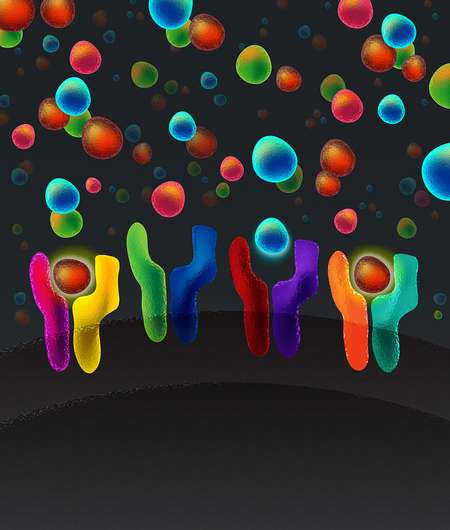Understanding the language of cellular communication

A team of Caltech scientists has uncovered a molecular code that cells use to communicate with each other. This "language" is thought to be common to many types of cellular communication and has implications for designing future therapies, according to scientists in the laboratory of Michael Elowitz, professor of biology and bioengineering at Caltech and an investigator with the Howard Hughes Medical Institute.
The work is described in a paper in the September 7 issue of Cell.
Just as humans use letters and words to create messages, cells release molecules called ligands into the environment to send messages to their neighbors—such as an instruction to differentiate or proliferate. The ligands bind to receptors on the surface of other cells, which interpret the message and trigger a set of chemical reactions to relay it to the correct molecules in the cell's interior.
The authors studied a major communication channel, called the bone morphogenetic protein (BMP) pathway, that operates in nearly all tissues and is a target for cancer therapies. This system uses many different ligands and receptors in various combinations. Oddly, the ligands and receptors in this pathway mix and match with each other in many different ways, seemingly for no reason.
"You might think each type of ligand would pair up with only one type of receptor, but this isn't the case," says Elowitz. "Instead, all of the ligands interact promiscuously with all of the receptors. It seems like a big mess, and quite different from the way people design communication systems to keep each communication channel separate. So we wondered why cells communicate in this way."
To figure out what benefit molecular promiscuity provides, the team created different mixtures of BMP ligands in the laboratory and added them to certain cells: breast cells, embryonic stem cells, and connective tissue cells called fibroblasts, all from mice. They found, surprisingly, that the cell decodes information from ligand combinations, not the individual ligands themselves.
"One day, I came to the lab and mixed two ligands together that, each on their own, activate cells very strongly," says Yaron Antebi, a Caltech postdoctoral scholar in biology and biological engineering. "But when I checked the cells the next day, there was no response at all. This led us to theorize that cells aren't listening to individual ligands, but rather to combinations of ligands. It's the combinations that are meaningful. Different combinations of ligands encode different instructions for the cell."
The group also observed that different kinds of cells can extract different information from the same ligand combinations by performing different computations—one cell may add the concentrations of two ligands to receive a message, while another may measure the ratio of the two ligands to decode another message. "We were amazed to find that there is not only one kind of information encoded in these ligands," says James Linton, a research scientist in the Elowitz lab. "Different cells can extract different messages, such as instructions to proliferate or differentiate, from the same molecules."
The group found that this ability to encode multiple messages using the same molecules arises because distinct cell types express different combinations of receptors on their surfaces.
One feature of this communication system is the ability for cells to address messages to specific cell types. "It's kind of like being in a crowded room where everybody is talking, and someone wants to get your attention so they shout your name," says Elowitz. "Everyone else might automatically ignore it, but you pay attention; you are the target of that message."
"This selectivity in communication is extremely useful," adds Antebi. "You can imagine that, if you had a broken bone, you would only want bone cells in the damaged area to proliferate and rebuild the damaged area, not all cells around them."
The findings provide a foundation for understanding how information is distributed across molecules. While the research is at an early stage, a better understanding of cellular communication could lead to designs for biological drugs that could target tumors or particular cell types without affecting any other cells.
The paper is titled "Combinatorial signal perception in the BMP pathway."
More information: Yaron E. Antebi et al. Combinatorial Signal Perception in the BMP Pathway, Cell (2017). DOI: 10.1016/j.cell.2017.08.015
Journal information: Cell
Provided by California Institute of Technology
















